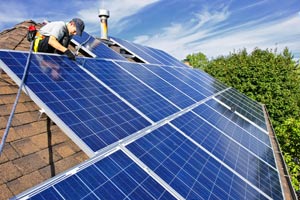 With the ever rising prices of electricity bills, dwindling supplies of fossil fuel resources and the urgent need for solutions to climate change, solar power is rapidly becoming known as a viable solution for environmentally and budget conscious homeowners.
With the ever rising prices of electricity bills, dwindling supplies of fossil fuel resources and the urgent need for solutions to climate change, solar power is rapidly becoming known as a viable solution for environmentally and budget conscious homeowners.
Solar panels comprise of photovoltaic cells, fitting on the roof of a house to convert sunlight into energy which can power the house, or be fed back into the national grid. When the sunlight hits the panels, a chemical reaction occurs which creates a direct current flow of electrons, feeding through an inverter and eventually converting into an alternating current. This direct current is what powers the home.
Whilst many people are under the impression that solar panels require sunshine to function, this is fortunately not true. Photovoltaic cells react to daylight, meaning that even on a completely overcast day, solar panels can generate around 40% of their potential electricity yield. Homes equipped with solar panels remain connected to the national grid, meaning that power can still be drawn from the grid outside of daylight hours. In addition, any energy that goes unused will be fed back to the national grid, meaning it will not go to waste. Homeowners will even be paid for this, thus strengthening the argument for solar energy.
The case for renewable energy in an environmental sense is gaining more and more traction by the day. A week seldom passes without a significant news story that involves the increasing price of oil and gas, or the devastating environmental impact of fossil fuel recovery; methods such as ‘fracking’ and tar sands which leave acres of land horribly polluted. Such methods can emit up to 45% more greenhouse gas than traditional oil and gas expulsion – and 100% more than solar. With oil production on the verge of peaking, solar power is widely recognized as a key part of a low-carbon future.
Another positive part of solar energy is the financial benefits. Government schemes have been rolled out in recent years which provide homeowners with compelling cost incentives. In 2010, the UK government introduced the Feed-in Tariff (or FIT as it is sometimes referred to). This incentive scheme encourages homeowners to invest in solar panels, ensuring a payment of 21 pence for each unit of electricity that a domestic solar panel system produces – regardless of whether the energy is used inside the home or fed back into the national grid. The tariff also pays 3 pence per until for electricity that is not used inside the home. This scheme is guaranteed for 25 years, with the payment amount likely to increase with inflation linked to the Retail Price Index.
With these systems in place, the homeowner can make a considerable profit over the lifecycle of their solar panels, as well as save money on electricity bills, ranging from £70 to £130 per year in the UK.
The technical details and installation are all taken care of by the solar panel providers, as well as maintenance and other responsibilities. Planning permission is often not needed.
Whilst panels and their installation can cost between £8,000 and £14,000, the feed-in tariff coupled with the savings means the homeowner can instantly start earning back the amount they invested. In addition, many panel providers offer free panels in return for feed-in tariff rights until the cost has been paid. The argument for solar energy is getting stronger by the day!
 Alternative Energy HQ solar power for homes, wind energy, and bio fuel issues
Alternative Energy HQ solar power for homes, wind energy, and bio fuel issues





